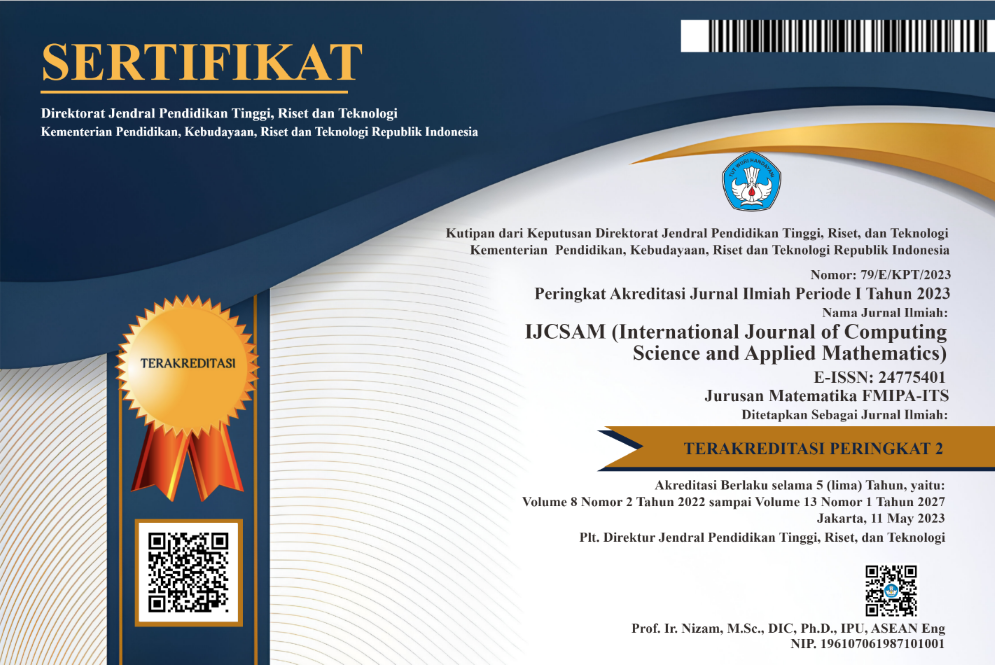Effect of Major Axis Length to the Pressure on Ellips
Abstract
Keywords
Full Text:
PDFReferences
F. Bouak and J. Lemay, “Passive control of the aerodynamic forces acting on a circular cylinder,” Experimental Thermal and Fluid Science, vol. 16, no. 1-2, pp. 112–121, 1998.
B. Widodo, “The influence of hydrodynamics on pollutant dispersion in the river,” Int. J. Contemp. Math. Sciences, vol. 7, no. 45, pp. 2229–2234, 2012.
A. Ladjedel, B. Yahiaoui, C. Adjlout, and D. Imine, “Experimental and numerical studies of drag reduction on a circular cylinder,” World Academy of Science, Engineering and Technology, vol. 77, pp. 357–361, 2011.
T. Y. and W. A. Widodo, “Flow characteristics around a d-type cylinder near a plane wall,” in Regional Conferences on Mechanical and Aerospace Technology, 2010.
T. Y. and M. Nuh, “Using of a bluff body cut from a circular cylinder as passive control to reduce aerodynamics forces on a circular cylinder,” in The International Conference on Fluid and Thermal Energy Conversion, 2003.
C. Imron and M. Yunus, “Mathematical modeling of pressure on cylindrical ellipse using side-by-side configuration,” International Journal of Computing Science and Applied Mathematics, vol. 1, no. 1, pp. 10–11, 2015.
S. Singha and K. Sinhamahapatra, “Flow past a circular cylinder between parallel walls at low Reynolds numbers,” Ocean Engineering, vol. 37, no. 8-9, pp. 757–769, 2010.
H. Sarvghad-Moghaddam, N. Nooredin, and B. Ghadiri-Dehkordi, “Numerical simulation of flow over two side-by-side circular cylinders,” Journal of Hydrodynamics, Ser. B, vol. 23, no. 6, pp. 792–805, 2011.
C. Imron, B. Widodo, and T. Yuwono, “Numerical simulation of fluid flow around circular and I-shape cylinder in a tandem configuration,” Applied Mathematical Sciences, vol. 7, no. 114, pp. 5657–5666, 2013.
D. Z. Noor, M.-J. Chern, and T.-L. Horng, “An immersed boundary method to solve fluid–solid interaction problems,” Computational Mechanics, vol. 44, no. 4, pp. 447–453, 2009.
A. L. E. Silva, A. Silveira-Neto, and J. Damasceno, “Numerical simulation of two-dimensional flows over a circular cylinder using the immersed boundary method,” Journal of Computational Physics, vol. 189, no. 2, pp. 351–370, 2003.
DOI: http://dx.doi.org/10.12962/j24775401.v2i3.2094
Refbacks
- There are currently no refbacks.
View My Stats

International Journal of Computing Science and Applied Mathematics by Pusat Publikasi Ilmiah LPPM, Institut Teknologi Sepuluh Nopember is licensed under a Creative Commons Attribution-ShareAlike 4.0 International License.
Based on a work at https://iptek.its.ac.id/index.php/ijcsam.






